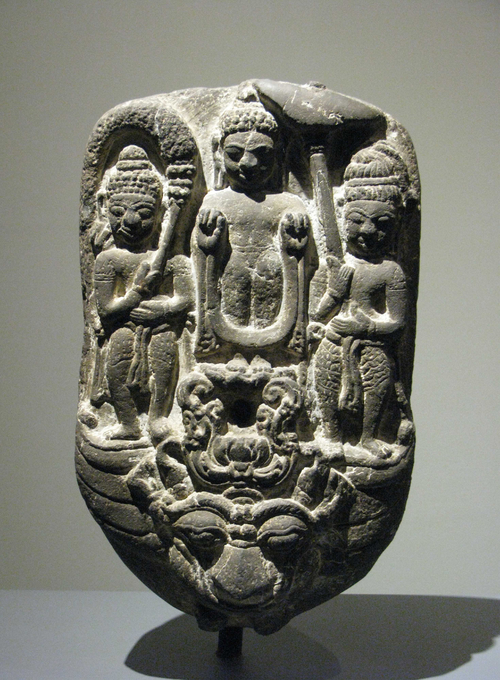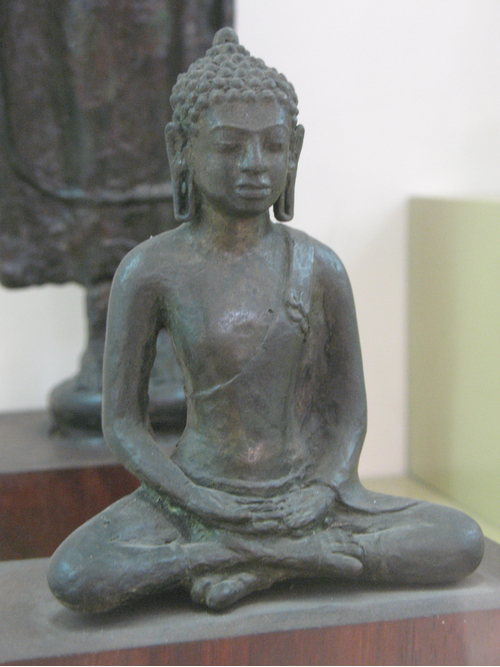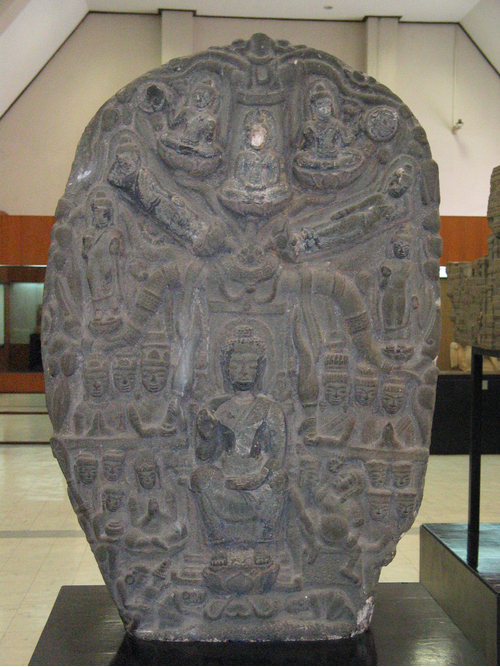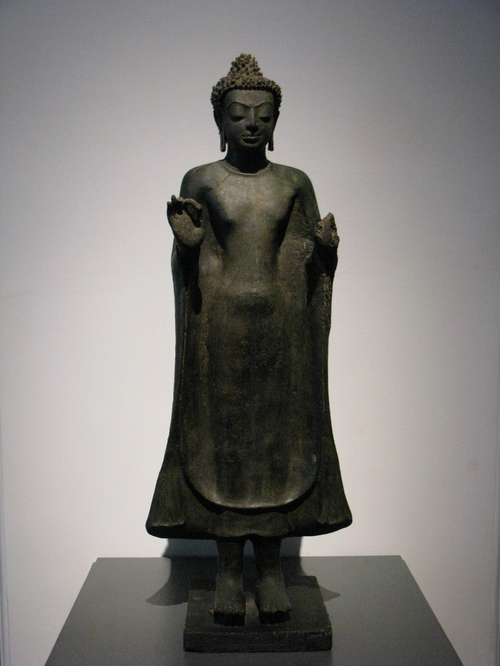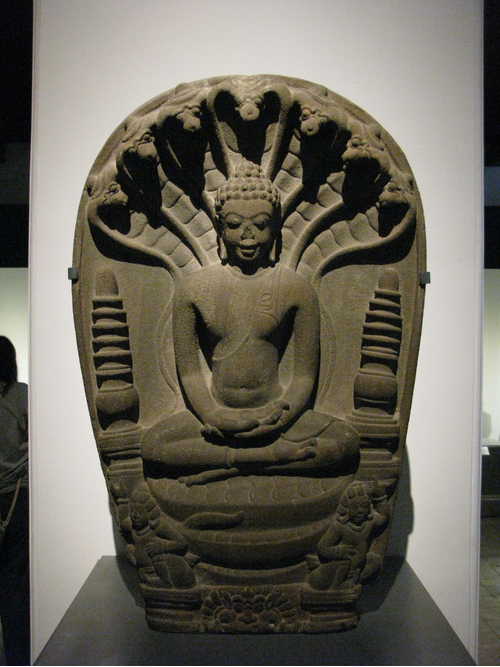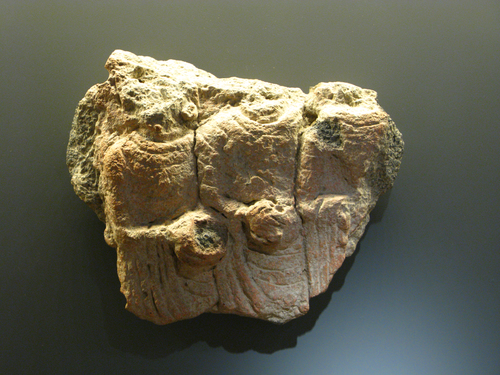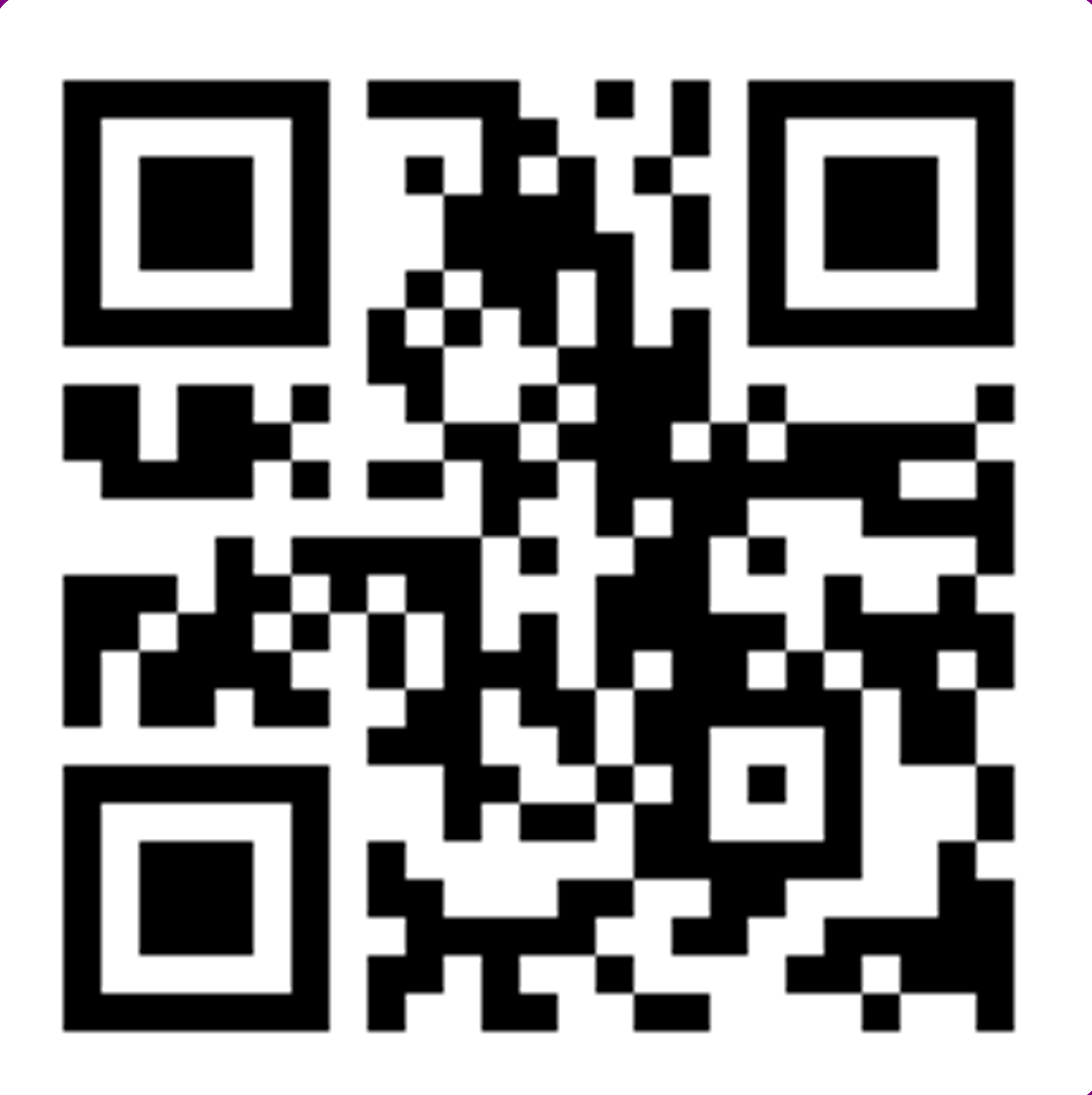ค้นหางานศิลปกรรม
ฐานข้อมูลศิลปกรรมในเอเชียตะวันออกเฉียงใต้
ประติมากรรมพระพุทธรูปประทับเหนือพนัสบดี
พระพุทธเจ้ายืนอยู่บนดอกบัวที่วางอยู่เหนือพาหนะ ขนาบข้างด้วยบุคคลข้างละ 1 คน พระหัตถ์ทั้งสองข้างทำปางแสดงธรรม มีรูเจาะทะลุปรากฏอยู่บริเวณฐานบัว พาหนะทำเป็นรูปสัตว์ผสมลักษณะเด่นคือ มีปีก มีจะงอยปากแหลม มีเขา นิยมเรียกพาหนะแบบนี้ว่า ตัวพนัสบดี รูปบุคคลยืนที่ยืนอยู่สองข้างนั้น ข้างหนึ่งถือแส้ ข้างหนึ่งถือฉัตร น่าจะเป็นพระอินทร์และพระพรหม
ประติมากรรมพระพุทธรูปประทับเหนือพนัสบดี
พระพุทธเจ้ายืนอยู่เหนือพาหนะ ขนาบข้างด้วยบุคคลข้างละ 1 คน พระหัตถ์ทั้งสองข้างทำปางแสดงธรรม มีรูเจาะทะลุปรากฏอยู่บริเวณพระชงฆ์ พาหนะทำเป็นรูปบุคคลขนาดใหญ่เห็นครึ่งตัว มีปีก สวมมงกุฎทรงกระบอก ถือดอกบัวในมือข้างละดอก บางท่านเรียกพาหนะแบบนี้ว่า พระอรุณาทิตย์ หรือพระอาทิตย์ เหนือดอกบัวแต่ละดอกเป็นรูปบุคคลยืน แม้จะชำรุดเสียหายแต่สังเกตได้ว่าบุคคลข้างหนึ่งถือแส้ สันนิษฐานว่าอาจเป็นรูปพระอินทร์และพระพรหม
ประติมากรรมพระพุทธรูปปางสมาธิ
พระพุทธรูปนั่งขัดสมาธิราบแบบหลวม ซ้อนกันเฉพาะพระบาท พระหัตถ์แสดงปางสมาธิ พระพักตร์เหลี่ยม พระขนงนูนเป็นสันและต่อกันเป็นปีกกา พระเนตรเหลือบต่ำและโปน พระนาสิกใหญ่ พระโอษฐ์แบะและกว้าง พระอุษณีษะเป็นต่อมนูนสูง มีพระรัศมีรูปดอกบัวตูมหรือลูกแก้ววางเหนือพระอุษณีษะ ครองจีวรห่มเฉียง เรียบไม่มีริ้ว บางแนบพระวรกาย
ประติมากรรมภาพสลักเล่าเรื่องยมกปาฏิหาริย์
แผ่นหินนี้สลักภาพเล่าเรื่องพุทธประวัติตอนแสดงยมกปาฏิหาริย์ที่เมืองสาวัตถีเพื่อปราบเหล่าเดียรถีย์ พระพุทธเจ้านั่งห้อยพระบาทบนบัลลังก์ซึ่งวางอยู่ใต้ต้นมะม่วง พระหัตถ์ขวาแสดงปางประทานธรรมทั้งสองข้างแวดล้อมด้วยภาพบุคคลจำนวนมาก แต่ละข้างมีเส้นตรงตามแนวนอนแบ่งกลุ่มบุคคลออกเป็น 2 กลุ่ม น่าจะสื่อว่าใต้เส้นตรงเป็นโลกมนุษย์ เหนือเส้นตรงเป็นสวรรค์ ดังนั้นกลุ่มบุคคลใต้แนวเส้นตรงที่อยู่ทางขวาของพระพุทธองค์น่าจะหมายถึงพระเจ้าปเสนทิโกศลพร้อมด้วยผู้ติดตาม ในขณะที่อีกข้างหนึ่งใต้แนวเส้นตรงเป็นเหล่าเดียรถีย์ที่พ่ายแพ้ สำหรับบุคคลที่อยู่เหนือแนวเส้นตรงเป็นทิพยบุคคลบนสวรรค์ โดยด้านขวาของพระพุทธองค์เป็นบุคคลสวมเครื่องทรงจำนวนมากน่าจะเป็นเทวดาที่นำโดยพระอินทร์ ส่วนด้านซ้ายเป็นบุคคลที่ครองเพศนักบวชน่าจะเป็นพระพรหม ถัดขึ้นไปด้านบนตามกิ่งก้านของต้นมะม่วงปรากฏภาพพระพุทธนิรมิตในอิริยาบถต่างๆ 7 องค์
ประติมากรรมพระพุทธรูป
พระพุทธรูปยืนทำปางแสดงธรรม แม้ว่าพระหัตถ์ซ้ายจะชำรุดแต่เชื่อได้ว่าทำปางแสดงธรรมเหมือนกันกับพระหัตถ์ขวา ครองจีวรห่มคลุม เรียบไม่มีริ้ว บางแนบพระวรกาย ชายจีวรเบื้องล่างด้านหน้าพาดผ่านพระชงฆ์เป็นรูปวงโค้ง ส่วนชายจีวรเบื้องล่างด้านข้างผายออกด้านนอก เป็นลักษณะที่พบได้ในพระพุทธรูปทวารวดีอีสาน พระพักตร์ค่อนข้างเหลี่ยม มีพระอุณาโลมกลางพระนลาฏ พระขนงนูนเป็นสันและต่อกันเป็นปีกกา พระเนตรเหลือบต่ำและโปน พระนาสิกใหญ่ พระโอษฐ์แบะและกว้าง พระอุษณีษะเป็นต่อมนูนสูง
ประติมากรรมพระพุทธรูปนาคปรก
พระพุทธรูปนูนสูงองค์นี้ทำเป็นปางนาคปรก พระพุทธองค์นั่งทำปางสมาธิอยู่เหนือขนดนาค ครองจีวรห่มเฉียง เรียบ บางแนบเนื้อ มีชายจีวรอยู่เหนือพระอังสาขวา นาคมี 7 เศียร ปกอยู่เหนือพระเศียรของพระพุทธเจ้า ใบหน้าละม้ายคล้ายลิงอันเป็นลักษณะเด่นของนาคแบบทวารวดี สองข้างของพระพุทธรูปสลักรูปเจดีย์ทรงกลมข้างละ 1 องค์ ถัดลงมาเบื้องล่างของเจดีย์มีรูปบุคคลนั่งเทินอยู่ ด้านล่างสุดใต้ขนดภาคมีลายหน้าสิงห์
ประติมากรรมพระสงฆ์อุ้มบาตร
ประติมากรรมนูนต่ำนี้เป็นดินเผา เดิมทีใช้สำหรับประดับเจดีย์ชำรุดเสียหายมาก สังเกตเห็นได้ว่าทำเป็นรูปพระสงฆ์ 3 รูป ยืนเรียงกัน แต่ละรูปครองจีวรห่มคลุม ถือบาตรไว้ในระดับหน้าท้อง
ประติมากรรมฐานธรรมจักร
ฐานรับธรรมจักรนี้ชำรุดเสียหายมาก ทำจากหิน มีลักษณะเป็นก้อนสี่เหลี่ยมที่เจาะทะลุจากตรงกลางจากบนลงล่าง ทำหน้าที่ยึดตรึงองค์ธรรมจักรกับเสาไว้ด้วยกัน ด้านทั้งสี่สลักภาพพุทธประวัติตอนปฐมเทศนาเหมือนกัน แต่แตกหักเสียหายมาก มีเพียงด้านเดียวที่เหลือรายละเอียดมากพอจะศึกษาได้ พระพุทธองค์ประทับนั่งห้อยพระบาทบนบัลลังก์ พระหัตถ์ขวาทำปางแสดงธรรม พระหัตถ์ซ้ายวางเหนือพระเพลา เบื้องล่างด้านซ้ายของพระองค์เป็นนักบวชพราหมณ์ 5 คน เชื่อว่าเป็นปัญจวัคคีย์ก่อนบวช ด้านขวาของพระองค์เป็นพระสงฆ์ 5 รูป เชื่อว่าเป็นปัญจวัคคีย์หลัง ถัดขึ้นไปทั้งด้านขวาและซ้ายเป็นภาพบุคคลที่เชื่อว่าเป็นเทวดาและพรหม
